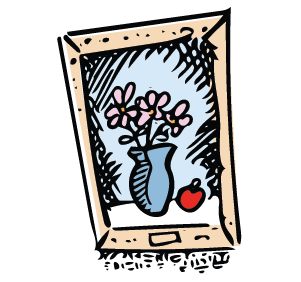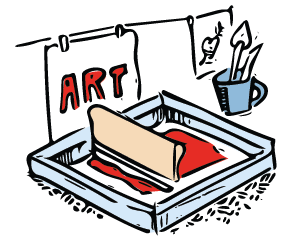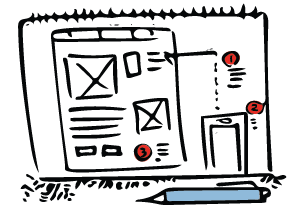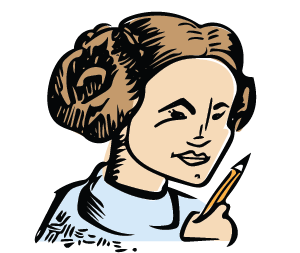The Scenic Route to Becoming a Designer: A Story of Leveraging One's Life Journeys

My interest and exposure in design started from a young age. My father and mother have been running a sign company for 40 years. They make hand-carved wooden commercial and residential signs. As a child, I watched him speak with customers while feverishly drawing ideas on a spare piece of paper. Napkins, old receipts and on his hands; any way to get his ideas out of his brain and onto something the customer could see and understand quickly. It was a fast iteration process where the bad ideas were thrown away and another piece of paper was in hand for new insights. You could see the sign take shape before your eyes. Rough at first, but honing in on the solution with each pass. Ideas spilling out and with a handshake, he would refine the napkin drawing into what would become a testament to craftsmanship, skill and design; a custom sign that embodied the intentions and personality of the customer or their business. I was imprinted with his process and it is still the one that I use today. Nothing is faster than a piece of paper and a pen, he always says.
Now speed forward to high school, where there wasn’t a class for design. We had art class and like every art class it was very free form. You made things without any particular reason. You didn’t have a client that dictated what you created. You didn’t solve customer conversion rates with a portrait of flowers.

I loved that nature of art. I didn’t have to please anyone. I made things for me for no reason. I could use the rainbow at my leisure. I could use whatever medium was near me. All the power was in my hands.
So when I went to college I became really interested in becoming a set designer. I loved the theater. I loved making drawings and models of sets. There weren’t any parameters aside from knowing what the play was about. I didn’t have anyone to dictate what things should look like. However, that was about to change when I got further into the degree. We began working with directors. Directors are the clients of the theater. They dictate the feeling of the play, which would completely affect the design of the sets. Since I had a taste of freedom when I did art in high school, I didn’t want anyone stifling me with their choices and tastes.

I decided to not go any further into set design and switched over to starting my fine arts degree. I was again in my comfort zone. Creating for the sake of making something. Trying every medium and getting my hands dirty. Painting car portraits because I was in love with chrome and the smooth lines of a 57’ Chevy Belair. I would complete the minimum requirements of the assignment and the rest was up to me. I had to create something out of nothing.
I graduated with a bachelors in fine arts, which meant I spent most of my college career in the world of making myself happy and simultaneously not hirable. There was a graphic design program in college, but I sneered at it since I wanted to be classically trained instead of making commercial art with a, …gasp, computer (selling out in my mind). If only I knew then that design was in my future and probably my calling. That would have saved me a ton of time and money.
A fine arts degree is not easily marketable. Starving artist isn’t just a saying. I realized that I missed an opportunity in college by not looking further into the future and learning graphic design. In order to be successful as a fine artist, you had to be either really good at fine arts or in the right place at the right time. I was a decent artist, but I was never in the right place or time. So I swallowed my pride, left my comfort zone, and enrolled in a graphic design program.

I discovered that I really enjoyed solving problems by harnessing my raw talent from art school and what I learned from my father by directing it into the computer. I excelled at it. I found a focus that I was missing in all those years in college. I enjoyed the homework because it made me think more rationally about why I was doing what I was doing. I now had to explain why I had picked out colors for something, why I chose an image for a poster, why I decided to incorporate a texture, why I did anything at all. However, most of the work was based on print design and I had very little web design knowledge by graduation. Again, I resisted learning HTML and CSS, similar to me resisting graphic design in college. Web design was not a requirement in school at the time, but I took a few classes to see what it was like.
After graduating, I was asked to join Bendyworks as their first designer. With only two classes of web design under my belt, I had to become the expert in design, UX/UI and anything encompassed the front end of websites and applications in a hurry. My fine art tendencies of (over)embellishment crop up all the time, however my fine arts background has taught me a lot about color and classical composition that I still leverage regularly today. When I began here, design felt like I had to just choose colors, fonts, and give some personality to a website or web app. And to the rest of Bendyworks, who were all backend developers, that was what made up the elements of design. I wasn’t aware that making things look cool and flashy didn’t solve all the needs of a client. I was missing a lot of the big picture by neglecting all aspects of design. What is UX? UI? What are design patterns? What’s a grid? What are the differences between desktop, mobile and responsive? What are native apps?

As a designer, I come across things that I never had to figure out while making art or designing for print. Websites are dynamic. Websites have to change shape, size and allow people to interact with it. You can’t change a canvas after you have painted on it. A print doesn’t allow you to click on buttons. There is nothing to navigate on a wooden sign. There are interactions that I never had to think about or consider until I started working on websites. Websites and apps are extraordinarily complex and powerful. I still have difficulty comprehending past the appearance since that is what I was trained to pay the most attention to. With time and experience I have and will develop design patterns; reusable design standards and the things that have worked well on my previous projects.
My fine arts background has taught me a lot about color and classical composition that I still leverage regularly today.
What has become abundantly clear is that I am more successful and comfortable when I can prototype what we plan on creating. The first prototypes usually consist of sketchy drawings on paper, heralding what I learned from my father’s process. Prototypes can reveal a lot of the missing pieces and questions, and gives you a platform to answer more. It makes me reevaluate where I put things like buttons or content and why. It broadens my view to see the whole application and not just a small section. Its like a Chuck Close painting, an artist who is known for gigantic portraits done with teeny dots. You have to step back to see the whole thing for what it is and not just fixate on a handful of dots. Even in art school I would do a quick sketch before I added any paint to the canvas to check the composition and balance of the elements that I was about to paint.

I am not on this journey alone. I have an incredible team to fill in the gaps and work side by side with. We are all learning together to make the best products and applications. They teach me the value of being agile with quick iterations, clear mockups, being concise and purposeful with everything I produce. Every pixel is accounted for and built by hand. I have a colleague, who is a design veteran, who pushes me to think about how to streamline my art behaviors and channel it into building interfaces, creating illustrations or unique experiences. As a team we bring out each others best skills and talents.
I have been here three years now and am still balancing design experience and patterns versus my gut reactions to make something “artistic”. Sure, application design isn’t what I was trained to do, but with time I know I’ll excel at it. We have the ability to level up our skills and learn on Fridays. We choose our own path and things we want to do. Sound familiar? I get to work on new skills and I still get to use my fine art skills. I get to leverage my art degree to make custom illustrations, logos and icons, which to me are tiny prints and paintings. Everyday I stretch my new talents in design and with a side of art while making clients and myself happy.
I am not on this journey alone. I have an incredible team to fill in the gaps and work side by side with.
Everyone’s journey is different. The experiences we make on the road of life influence the choices we make and can only help shape your career. You can take the girl out of art but you can’t take the art out of the girl. My only regret is that I didn’t see how much design influenced my life in the beginning. My parents would joke when I realized my potential that I was coming to the dark side of the force. Well if that is true, I made one hell of a Leia.
